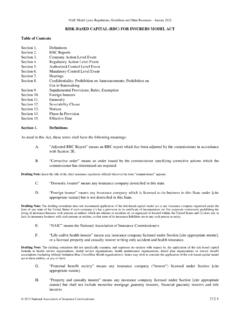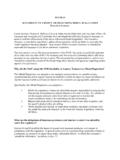Transcription of How Do Managed Care Plans Reduce Healthcare Costs?
1 How Do Managed care Plans Reduce Healthcare Costs? Jessica Van Parys October 29, 2014 JOB MARKET PAPERA bstractThe US public health insurance market is shifting toward reimbursement models that trans-fer risk away from the government and toward health insurers and Healthcare providers. Insteadof paying fee-for-service (FFS) to Healthcare providers, Medicaid and Medicare now outsourcehealthcare delivery to Managed care Plans and the Plans accept risk related to their enrollees Healthcare costs. Previous research reaches mixed conclusions about whether Managed careplans actually Reduce costs. In this paper, I study Florida s 2006 Medicaid Reform, whichmandated that Medicaid beneficiaries switch from the state s FFS system to (1) insurer -ownedplans, (2) hospital-owned Plans , or (3) physician-owned Plans .
2 I find that insurer -owned plansreduced costs by 7-12% in all reform markets, but insurers in different markets reduced costsin different ways. Insurers reduced the number of hospital visits after a hospital plan enteredone market, but insurers reduced the average cost per hospital visit after physician Plans en-tered another market. Motivated by these empirical findings, I show how insurers choose theirstrategies in different markets. The results suggest that insurers have leverage in how theyreduce costs, but that competition with provider Plans may restrict their options. I would like to thank Doug Almond, Janet Currie, Tal Gross, Kate Ho, Bentley MacLeod, and the applied microe-conomics colloquium at Columbia University for their comments and suggestions.
3 This project was supported by grantnumber R36HS023504 from the Agency for Healthcare Research and Quality. The content is solely the responsibilityof the author and does not necessarily represent the official views of the Agency for Healthcare Research and Quality. Economics Department, Columbia University, 420 West 118th Street MC 3308, New York, NY IntroductionThe US public health insurance programs, Medicaid and Medicare, now account for 24% of federaland state budgets, and expenditures on these programs are expected to grow by 6-8% per yearthrough 2023 (CMS 2013;[9]Rudowitz 2014[39]). One in three US citizens is currently enrolled ina public health insurance program and enrollment is expected to increase as the population agesand states expand Medicaid eligibility under the Patient Protection and Affordable care Act (CMS2013;[9]State Health Facts Medicaid Expansion 2014[40]).
4 As Healthcare expenditures consumean increasing share of public expenditures, state and federal governments are under increasingpressure to Reduce program costs (Boyd 2014;[7]State Budget Crisis Task Force 2012[37]).One of the most championed initiatives to Reduce government Healthcare expenditures is toswitch beneficiaries from the fee-for-service (FFS) system to Managed care Plans . Historically,Medicaid and Medicare paid a fee for every service to Healthcare providers to treat patients. TheFFS system, however, encourages the over-utilization of medical resources, so Medicaid and Medi- care have been shifting beneficiaries to Managed care Plans .
5 Managed care Plans are owned andoperated by health insurers or Healthcare providers and they are responsible for coordinating theirbeneficiaries Healthcare . Managed care Plans have incentives to Reduce Healthcare costs relativeto the FFS system, yet it is unclear whether Plans actually Reduce costs or how they might doso. Moreover, governments often reimburse Managed care Plans in a way that makes it difficultto realize cost -savings from Managed care . This paper contributes to the literature by showinghow Managed care Plans Reduce their own Healthcare costs, which may help governments redesignreimbursements to share in paper uses the rollout of Florida s 2006 Medicaid Reform to show how switching fromFFS to Managed care affects total hospital costs.
6 Hospital costs include costs associated withemergency room visits (ER) and hospitalizations and they account for the largest share of Medicaidexpenditures (CMS 2013;[9]State Health Facts Medicaid Expenditures 2012[15]). Florida s reformmandated that Medicaid children, families, aged, and disabled beneficiaries in five counties switchfrom the state s FFS system to Managed care Plans . Medicaid beneficiaries in the remaining 62counties were not required to switch Plans . Since not all beneficiaries were required to switchplans, the reform generated precise treatment and control groups and the groups are quite similaralong many observable dimensions.
7 Therefore, to calculate the impact of the switch from FFSto Managed care , I estimate a difference-in-difference model where I compare total hospital costsin reform counties to total hospital costs in non-reform counties before and after the reform s 2006 Medicaid Reform is also one of the first examples where health insurers andhealthcare providers competed directly for beneficiaries, so it provides a laboratory in which to2test whether competition between insurers and providers affects insurers strategies to Reduce s five reform counties were located in two geographically distinct but equally-sized mar-kets and different Managed care Plans operated in different markets.
8 insurer -owned Plans operatedin both markets, but a hospital plan entered the Northeast Florida market, while physician plansentered the Southeast Florida market. Since different types of provider-owned Plans entered dif-ferent markets, I explore the heterogeneous effects of the reform across markets and I show thatinsurers adopted different strategies to Reduce costs in different results of the empirical analysis reveal that switching from FFS to Managed care reducedhospital costs by 7-12% in both markets, but that insurers reduced costs in different ways in differ-ent markets. In Northeast Florida, insurers reduced the number of nonemergency hospital Southeast Florida, insurers reduced the average cost per hospital visit.
9 Consistent with thesefindings, I write a model to explain how insurers choose their strategies to minimize costs and Ishow that their optimal strategies depend on competition with provider-owned the model , Plans choose a combination of three labor inputs to minimize the total costsof producing a fixed amount of medical care for their enrollees. The three labor inputs are, (1)the number of primary care physician hours, (3) the number of in-network ER physician hours,and (3) the number of out-of-network ER physician hours. By increasing the number of primarycare physician hours, Plans Reduce the number of nonemergency hospital visits.
10 By increasing thenumber of in-network ER physician hours, Plans Reduce the average cost per hospital visit. I showthat as the marginal cost of primary care physician hours increases, Plans substitute away fromprimary care physicians and toward ER physicians. Similarly, as the marginal cost of in-networkER physician hours increases, Plans substitute away from in-network ER physicians and towardprimary care model generates different predictions for different markets. The predictions depend onwhether insurers compete with hospital Plans or with physician Plans . When hospital Plans formexclusive contracts with their ER physicians, they Reduce the short run supply of ER physiciansavailable to insurers.
















